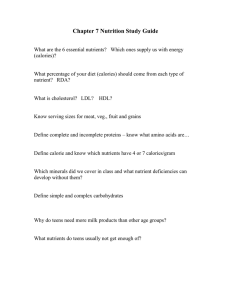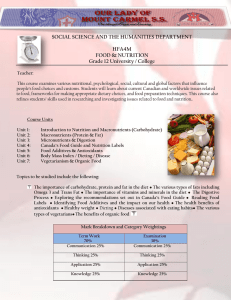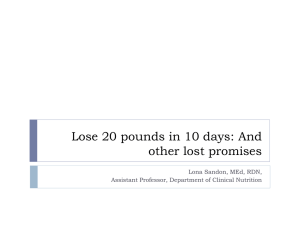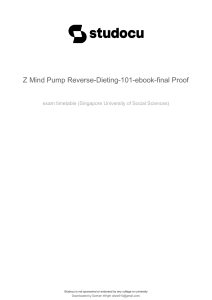Poor Nutrition and Obesity
advertisement
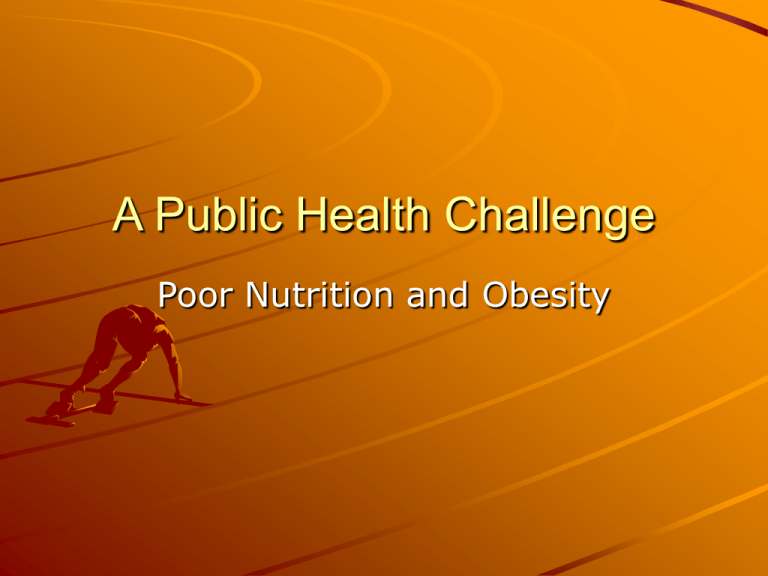
A Public Health Challenge Poor Nutrition and Obesity The Public Health Issue It is estimated that 55% of the adult population in the United States are either obese or overweight.* Obesity substantially increases an individual’s risk of suffering from chronic diseases such as hypertension, coronary artery disease, and diabetes. Those with excess fat in the abdominal area are at increased health risk* *National Institutes of Health, National Heart Lung, and Blood Institute, 1998 The Relationship between Fat Loss, Exercise, and Diet The addition of exercise to a diet with restricted caloric intake promotes fat loss, while maintaining fat free mass. Physical activity, without caloric restriction, minimally if at all affects fat loss. To optimize weight loss, a combination of diet and exercise is best, and that exercise alone will not suffice. Predictors or Mediators of Poor Nutrition An unhealthy lifestyle, Bad health, Low self-rated care of one’s own health, Perceived susceptibility of cardiovascular disease, Motivation towards dietary changes and Low self-efficacy about increasing physical activity, and Overweight and impaired glucose tolerance. Diet or Exercise: Which is Better to Lose Weight? According to the Pew Research Center, about a third (34 percent) of Americans are neither exercising nor dieting; Seventeen percent are doing both; Eight percent are dieting but not exercising; and Forty percent are exercising but not dieting. So, Who is Right? A recent study appearing in the Journal of Clinical Endocrinology & Metabolism demonstrated that dieting and exercise are equally good at taking off the pounds The key is that as long as the number of calories consumed is the same as the number of calories burned you will loose weight. It Depends!* If you can exercise enough to burn more calories and would rather do that than cut calories, then exercise is the way to go. If, however, you're more willing to trim your portions than go out running, dieting will work better." Think about which you would rather do: Skip the mayo on your burger, or walk it off for 35 minutes? *According to David L. Katz, M.D., associate professor of public health and director of the Prevention Research Center at Yale University School of Medicine The View from the Top It's clear from the research that the majority of people who have lost weight and kept it off for five years or more combine diet and exercise. It's nearly impossible to exercise enough to control weight without attention to diet. Conversely, it's nearly impossible to sustain weight loss without some increase in physical activity. An Added Benefit An increase in physical activity offers other benefits, including: – cardiovascular health, and strength training – can add muscle, which can burn extra calories at rest (each pound of muscle added will increase the calories your body burns by about 30-50). Not a Well Known Fact* Many truly obese people don't eat much but don't move much, either (hence their weight stays the same). Some are eating at starvation levels but sit in a chair all day. Once they start moving, they lose weight.. *Stephen Rice, M.D., Ph.D., M.P.H., a sports medical expert at the Jersey Shore Medical Center in Neptune, NJ Lifestyle Changes: Should you eat three or six meals per day? The answer is that it really depends on whether those six meals are going to increase or decrease how many calories you take in for the day overall. A small amount of research says that eating mini-meals consisting of less food more frequently may help rev metabolism and prevent extreme variations in blood sugar. At the very least you should eat three times daily. Some people reap benefits from eating about every four or five hours daily. Lifestyle Changes: Scheduling Exercise Which is better for you--walking for 15 minutes each day or going on an all-day hike on the weekend? – It’s pretty much unanimous among health experts*: The daily walk, even for a few minutes, is better than the allday hike on the weekend. – If you have the time to walk 15 minutes each day, it is better for your health and fitness. EXERCISE WITHOUT WEIGHT LOSS: THE HEALTH CONNECTION Excess fat in the abdominal area independently increases an individual’s risk of insulin resistance and high blood lipids. This distribution of body fat is also a strong predictor of cardiovascular disease.* It has been shown that weight management programs resulting in a loss of total body fat also reduce a person’s amount of abdominal fat. This loss of abdominal fat is associated with a decreased risk of cardiovascular disease. *Grundy et al., 1999, National Institutes of Health, National Heart Lung, and Blood Institute, 1998. EXERCISE WITHOUT WEIGHT LOSS: THE HEALTH CONNECTION However, it has been shown that exercising individuals, who do not experience any overall weight loss still decrease their risk of suffering from cardiovascular disease.** In the event that weight loss is not achieved, a person who is at increased risk of coronary artery disease (CAD), or its comorbid conditions (i.e., high blood pressure, glucose intolerance, insulin resistance), still benefits from regular aerobic exercise participation. ** Ross & Janssen, 1999. The Public Health Goal Regular, moderate-intensity physical activity, such as brisk walking, for 30 to 60 minutes on most days of the week. Daily exercise performed at a moderate intensity for 45 to 60 minutes a day without deceasing caloric intake. More research is needed with overweight and obese female populations to validate these benefits in women. Doctors skimp on diet, exercise advice New findings from one of the most comprehensive health surveys in the nation may shed light on one of the reasons obesity and diabetes are tough problems to solve - primary care physicians, the main gatekeepers of health information, aren't talking enough about the need for good nutrition and exercise. Data from the California Health Interview Survey, an analysis of phone interviews from about 46,000 residents in the state, showed just 34 percent of adults said their doctors discussed exercise with them and 28 percent discussed nutrition. The research "suggests that physician involvement may be a piece of the puzzle in obesity.“* *Sue Holtby, senior research scientist at the Public Health along with the UCLA Center for Health Policy Research. Institute, which conducted the survey The Problem from a Public Health Perspective* Physicians have so many competing demands in the office. They have more adults coming in with chronic illnesses, and their focus is on addressing patients' immediate needs. Preventative needs tend to get relegated to the back burner, especially when the patient is in and out in 15 minutes. *Dr. Lisa Santora, chief medical officer for the California Beach Cities Health District Other Opportunities to Educate Most hospitals have nutrition programs and dieticians on staff. City Health District holds numerous community programs and works closely with schools. One of the focuses of education has been improving healthful eating at home, with the hope that children will be encouraged to change. Since nearly three-quarters of adolescents discuss nutrition and exercise with their doctors, encourage doctors to educate young patients. What Does the Public Health Research Say to Do?
